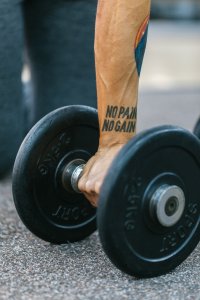When it comes to fitness, the phrase “No Pain No Gain” is as iconic as it is controversial. For decades, gym-goers and athletes have embraced it as a badge of honor. But is there a point where the burn becomes too much? Understanding the balance between effort and safety is critical for reaching your fitness goals without risking injury. By the end of this article, you’ll know how to harness the true meaning of “No Pain No Gain” while keeping your health intact.

The Origins of “No Pain No Gain”
“No Pain No Gain” has been a motivational mantra in the fitness world for years. But what does it really mean? The idea is rooted in the concept of pushing your body beyond its comfort zone to achieve growth, whether it’s building muscle, improving endurance, or burning calories. However, confusion often arises when pain, a natural part of progress is mistaken for injury. Discomfort during exercise can signal that your muscles are working, but sharp or persistent pain might be a warning sign that something is wrong.
Understanding the “Burn”
The “burn” is often the result of lactic acid buildup in the muscles during intense exercise. It’s a sign that your body is working hard and pushing itself. But how much is too much? The key is learning to differentiate between productive discomfort and harmful pain. Productive discomfort may feel intense, but it subsides quickly after exercise. Harmful pain, on the other hand, can linger or worsen, indicating a possible strain, tear, or overuse injury. Remember, “No Pain No Gain” should not mean ignoring the signals your body gives you.
When to Push Through
It’s important to challenge yourself at the gym, especially if you’re aiming to build strength or endurance. Mild discomfort and the “burn” are signs that your body is adapting to the workout. Push through when:
-
The discomfort is even and not sharp.
-
You’re performing controlled movements with proper form.
-
The sensation fades quickly after resting.

Recognizing Your Limits
The phrase “No Pain No Gain” doesn’t mean ignoring your body’s limits. Overtraining can lead to injuries, fatigue, and burnout, which derail your fitness journey. Listening to your body is crucial. If you experience sharp or stabbing pain, stop immediately. Additionally, signs of overtraining include prolonged soreness, trouble sleeping, and decreased performance. Recognizing these symptoms can save you weeks or even months of recovery time.
Common Mistakes
Many fitness enthusiasts make the mistake of equating pain with progress. This mindset can lead to poor form, overuse injuries, and frustration. Always prioritize technique over intensity, and don’t hesitate to consult a trainer if you’re unsure about a specific exercise. Remember, smart training is sustainable training.

Benefits of Moderation
While “No Pain No Gain” emphasizes effort, moderation is the secret to long-term success. Gradual progression not only reduces the risk of injury but also improves consistency, which is key for results. Incorporating rest days, stretching, and low-intensity workouts can enhance your recovery and performance. Moderation allows you to train smarter, not just harder.
How “No Pain No Gain” Fits Your Goals
Your interpretation of “No Pain No Gain” should align with your fitness objectives. Whether you’re aiming for weight loss, muscle gain, or improved endurance, the right balance of effort and recovery will ensure progress. For example, strength training involves controlled discomfort to build muscle, while cardio sessions require endurance without overexertion. Tailor your approach to your goals for optimal results.

Tips for Staying Safe While Feeling the Burn
-
Warm Up Properly: A thorough warm-up prepares your muscles for intense activity and reduces injury risk.
-
Use Proper Form: Good technique ensures that you’re targeting the right muscles and minimizing strain.
-
Progress Gradually: Increase weights, reps, or intensity slowly to avoid overloading your body.
-
Rest and Recover: Schedule rest days to allow your muscles to repair and grow.
-
Hydrate and Fuel Your Body: Staying hydrated and eating nutrient-dense foods support your performance and recovery.
Final Thoughts on “No Pain No Gain”
The phrase “No Pain No Gain” captures the spirit of determination, but it’s not a license to ignore your body’s signals. Feeling the burn is a natural part of growth, but knowing when to stop is just as important. By balancing effort with caution, you can achieve your fitness goals without compromising your well-being. At Fit4Blast, we’re here to help you navigate your fitness journey with expert guidance and personalized support. Ready to take your workouts to the next level? Visit www.fit4blast.com today to get started.




